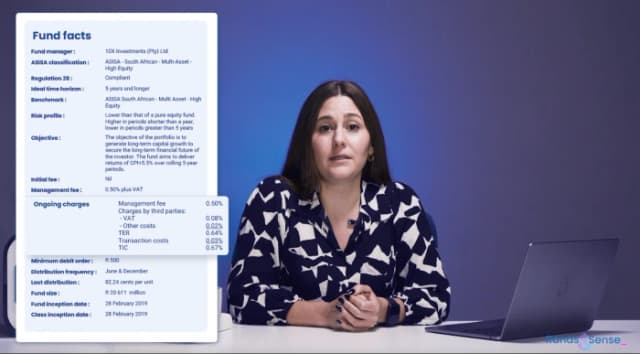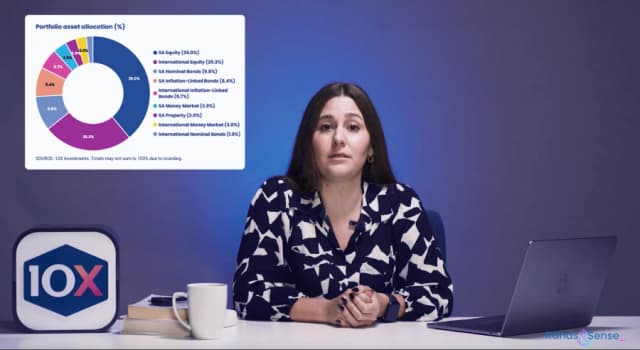Living Annuities and sustainable retirement Income: How much do you need to retire comfortably?
12 December 2024
A living annuity is a retirement savings investment product that allows you to draw a regular income in retirement while keeping your initial capital invested. A living annuity allows you to adjust your drawdown rate annually (between 2.5% and 17.5%), as well as adjust your investment portfolio and asset allocation strategy according to your changing needs and risk tolerance. For all the answers to our most popular living annuity questions, see our Living Annuity FAQ page.
Plan for a comfortable retirement with our
Living Annuity calculatorFinancial stability is the key to a comfortable retirement and a living annuity can help you achieve this by striking a balance between capital preservation and capital growth. To maintain financial stability throughout retirement, the first step is to make sure that your living annuity is optimally funded. The amount you initially invest in your living annuity will directly affect the longevity of the retirement savings investment product. The more you save for retirement during your working years, the more money you have to invest in your living annuity – and with more capital in your living annuity, the power of compounding can work in your favour, generating higher returns to last you throughout retirement.
Sufficient retirement savings – when invested carefully – can set you up for a comfortable retirement without running the risk of exhausting your funds prematurely. Alongside the initial capital invested in your living annuity, several factors play a crucial role in determining the sustainability of the retirement savings product. These include your drawdown rate, asset allocation, investment performance, inflation rates, and fees. Understanding these variables can help you make informed decisions regarding your portfolio management and withdrawal strategies, to achieve a stable and secure financial future.
In this brief guide, we will be covering a few crucial things to consider when investing in a living annuity. If you’re wondering how much you will need to save to reach your retirement goals or worrying about whether your money will last throughout your retirement, this guide is here for you.
Sustainable retirement income: Running the numbers
One of the biggest sources of financial stress as you transition into retirement is figuring out how much capital you will need and making sure that your investments generate enough returns to sustain you throughout your retirement years. It’s important that you are aware of your potential capital requirements before diving into a living annuity investment as this will help you determine your asset allocation strategy and establish sustainable drawdown rates to meet your retirement goals.
9 out of 10 people do better with 10X
Keeping your drawdown rates below a certain threshold and investing in growth assets can help you achieve returns that outpace inflation. However, a critical question remains: how much capital should you aim to accumulate by retirement, and what level of returns are necessary to maintain financial independence throughout retirement?
Retirement expenses will vary drastically from one person to the next, and it’s nearly impossible to predict all future costs with certainty; there is no one-size-fits-all solution to guarantee a comfortable retirement. However, there are some guidelines you can follow to prepare and manage your retirement funds. One general rule of thumb is to aim for 150% of your estimated required capital to cover for any unplanned expenses, emergencies, or unforeseen market fluctuations. This is sometimes referred to as the ‘safe capital requirement’, meaning a target amount that provides a buffer against unforeseen expenses or market fluctuations. In order to determine this value you would perform the following calculation:
- Determine your desired annual income at retirement.
- Subtract all other income sources that will contribute to this figure.
- Divide the remaining income requirement by 5%.
- Multiply the result by 150%.
Take this hypothetical example:
- Desired income: R40,000 per month (R480,000 annually)
- Subtract other income: R180,000 annually (e.g., rental income)
- Remaining income need: R300,000 annually
- Divide by 5%: R6,000,000 (capital needed for a 5% drawdown rate)
- Multiply by 150%: R9,000,000 (safe capital target)
Alongside this formula, it’s also important to take inflation into account. Some retirees assume they’re in a good position if their portfolio returns exceed their drawdown percentage. However, this overlooks the impact of inflation on purchasing power. Without accounting for rising inflation rates, even a portfolio that seems sufficient can fall short in maintaining your retirement lifestyle over the long term.
This is where you can make use of another formula, the “Golden Equation”, which takes drawdowns, fees, and inflation into account. We will touch on this formula further down. The 10X Living Annuity Calculator can also be used to calculate how much capital you require in order to maintain your desired retirement income. By inserting your current age, retirement age, and your retirement savings, the calculator will generate an expected monthly income using a drawdown rate of 5% and an inflation rate of 6%. You are also able to toggle between ‘average returns’ and ‘below average returns’ as well as ‘investment’ and ‘income’ values.
Living Annuities: Risks to consider
Before jumping into how to bolster your retirement income, we first need to consider the risks of living annuities and how best to address them. Living annuities carry specific risks that you will need to consider in order to manage your retirement funds effectively and secure a comfortable retirement.
First and foremost, living annuities are vulnerable to market volatility. When markets are in a downward cycle, the value of the capital will be reduced as the underlying investments are negatively affected. Your living annuity funds will typically be invested in a variety of asset classes, all of which are subject to market fluctuations. Since the income from a living annuity depends on the performance of these investments, market downturns can pose a problem. This risk is exacerbated if you choose to withdraw your funds during a market downturn as this can deplete your capital faster than expected and reduces the future income potential of your living annuity. This is where strategic and, importantly, diversified asset allocation comes into play – alongside sustainable drawdown rates that are reduced during market downturns to keep more of your capital invested.
Diversified asset allocation is based on the idea of not putting all of your eggs in one basket. By diversifying your portfolio, you are ensuring that none of the asset classes are too heavily invested in, so that in the event of an economic downturn in a particular asset class, the effect on your portfolio is mitigated. In addition, by diversifying across a variety of industries, and even offshore, you are ensuring that you are also exposed to upturns in market activity and can reap these rewards.
Longevity risk is also a very real concept, especially in today’s age where medical technology has advanced drastically. You may live significantly longer than the average life expectancy of your age group, and you need to ensure that you have sustainable retirement income available for this. If your drawdown rate is too high, if you’re paying high investment fees, or if your investment strategy is too conservative too early, there is a chance that your funds could be depleted and you could end up running out of money in retirement. Addressing longevity risk involves sustainable drawdown rates, diversified asset allocation according to your time horizon and risk tolerance, a careful consideration of the fees you pay on your investment, and of course, taking inflation into account.
So, let's talk about inflation risk. The purchasing power of the capital that you have available will decrease over the years as the price of goods and services increase. You would ideally want your living annuity investment to be earning a rate of return above the inflation rate in order for your investment to continue growing, but there are other factors that can exacerbate the negative impact of inflation on your retirement income.
When the fees you pay on your living annuity investment are too high, you run the risk of failing to keep pace with inflation. High investment fees can quickly eat into your capital, diminishing the growth of your investment. Your drawdown rate will also determine the sustainability of your living annuity and your ability to keep pace with inflation. Setting a drawdown rate that is too high can deplete your funds too quickly, especially if investment returns are low or if inflation is high.

This is where the “Golden Equation” formula proves useful in helping you maintain financial stability and keep pace with inflation. It looks like this:
Drawdowns + Fees + Inflation ≤ Return on Investment
(Drawdowns refer to the income you withdraw, fees include all charges on your investment, and inflation represents the rate of increase in costs.) The formula is quite simple: your total expenses – including your drawdown, fees, and the impact of inflation – must not exceed the returns your investments generate. Balancing these factors is crucial to ensure your savings last throughout your retirement years.
Strategic asset allocation will also help you weather inflation risk. A well-diversified portfolio that includes assets with growth potential can generate returns that outpace inflation over the long term. However, it’s equally important to take into account your time horizon and risk tolerance, as this will help you strike a balance between capital growth and capital preservation, with a mix of assets that suit your retirement scheme.
Time horizon refers to the amount of time in which you need your retirement capital to work for you. If you have a longer time period afforded to you, you are able to increase your equity exposure in your living annuity investment and this will result in more capacity for growth. Conversely, if your time horizon is shorter, you may be more risk averse as you need to protect your capital and will therefore make more conservative choices in terms of underlying investments.
Risk tolerance is another consideration which can impact the decisions you make. The higher your risk tolerance, the more willing you are to take on risk in order to pursue higher returns. If your risk profile is low, you would opt for a more stable long term investment with more guaranteed – albeit lower – returns.
How to avoid running out of money in retirement
Keep fees in mind
As mentioned earlier, high fees compound over time, diminishing returns and eroding your capital. Lower fees, on the other hand, allow more of your returns to be reinvested, letting compounding work in your favour. When fees are kept to a minimum, your capital is able to grow more effectively. It’s important to understand the effective annual cost (EAC) of your investments and choose a living annuity provider with low fees and complete transparency. Try out our handy EAC calculator to see how much you could be saving with 10X Investments.
Always consider inflation
Inflation reduces your purchasing power over time and this could greatly affect retirement income derived from an investment like a living annuity. You would therefore want to pursue investments that will outperform inflation in order to be able to maintain your current standard of living. Growth assets (such as equities and real estate) are ideal for this purpose as they have the ability to produce returns above the inflation rate.
Diversified asset allocation
Asset allocation is another important consideration when managing your living annuity investment. Your investment funds will be split between a variety of asset classes like real estate, equities, bonds, and cash – and each of these asset classes will have a different rate of risk and return, thus allowing you to diversify your portfolio, minimise risk associated with any single asset class, and generate growth on your investment to keep pace with inflation.
Set sustainable drawdowns
While you are setting up your living annuity, you will have the opportunity to select an appropriate drawdown rate between 2.5% and 17.5% per annum. You are able to adjust your drawdown each year, depending on your needs. In order to preserve your capital, it’s usually a good idea to choose a more conservative drawdown rate. If your chosen drawdown rate is on the higher side, you would risk depleting your capital too quickly and rising inflation rates could overtake your retirement savings.
Let’s compare the effects of different drawdown rates on your capital. For example, let’s say you have a capital investment amount of R1 million and you have a drawdown rate of 4% per annum. An inflation rate of 5% is assumed to illustrate how withdrawal amounts increase over time.
Year 1: You withdraw R40 000
Year 2: You withdraw R42 000 (adjusted for inflation)
Year 3: You withdraw R44 100 (adjusted for inflation)
With a 4% drawdown, your capital is likely to last for 30+ years, allowing for compounding growth. If you increase the drawdown rate to 6% per annum:
Year 1: You withdraw R60 000
Year 2: You withdraw R63 000 (adjusted for inflation)
Year 3: You withdraw R66 150 (adjusted for inflation)
At 6%, your capital may last around 20 to 25 years, reducing long-term sustainability. If you increase the drawdown rate to 8% per annum:
Year 1: You withdraw R80 000
Year 2: You withdraw R84 000 (adjusted for inflation)
Year 3: You withdraw R88 200 (adjusted for inflation)
An 8% drawdown significantly increases the risk of depleting your capital within 10 to 15 years.
In summary, to maximise your retirement income, aim for a sustainable drawdown rate that preserves capital, supports compounding growth, and mitigates the risks of inflation. Talk to a 10X retirement investment consultant today (at no cost to you) to make sure your investments are doing the most they can for you.
Related articles

How can we 10X Your Future?
Begin your journey to a secure future with 10X Investments. Explore our range of retirement products designed to help you grow your wealth and achieve financial success.




